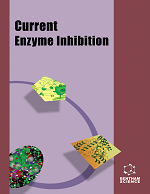- Home
- A-Z Publications
- Current Enzyme Inhibition
- Previous Issues
- Volume 18, Issue 1, 2022
Current Enzyme Inhibition - Volume 18, Issue 1, 2022
Volume 18, Issue 1, 2022
-
-
Ovine COX-1 Isoenzyme Bio-production
More LessBackground: Recent findings enlightened the pivotal role of cyclooxygenases-1 and -2 (COX-1 and COX-2) in human diseases with inflammation as the committed earliest stage, such as cancer and neurodegenerative diseases. COXs are the main targets of nonsteroidal anti-inflammatory drugs and catalyze the bis-oxygenation of arachidonic acid into prostaglandin PGH2, then converted into prostaglandins, thromboxane, and pr Read More
-
-
-
A Simplified Direct O2 Consumption-Based Assay to Test COX Inhibition
More LessAuthors: Maria G. Perrone, Morena Miciaccia, Savina Ferorelli and Antonio ScilimatiBackground: Cyclooxygenase is a well-known oxidoreductase that catalyzes the uptake of two moles of O2 by arachidonic acid (AA), producing the hydroperoxide Prostaglandin G2 (PGG2), then reduced to the prostaglandin precursor Prostaglandin H2 (PGH2). O2 consumption during such reactions is a measure of cyclooxygenase activity. O2 involved is generally measured by indirect methods, accomplished in the presenc Read More
-
-
-
New Nonsteroidal Molecules as Blockers of the Steroidogenic Pathway
More LessAuthors: Jhoan H. Piermattey, Maicol Ahumedo, Yvonne Heuze, Juan Soriano and Marisa CabezaBackground: Testosterone circulating levels decrease in aging. This fact affects the emotional response to captivating pictures. Therefore, naturally increasing androgens within neurons could be a way to improve the mood of aged people. Objective: This study aimed to determine the biological activity of new nonsteroidal derivatives of 2- aminonaphthalene-1,4-dione (2-amino-3-iodonaphthalene-1,4-dione and 2-(iodoamino)-3- Read More
-
-
-
Ultrasonic Assisted Synthesis, Biological Evaluation, and Molecular Docking of Chalcone-based 1,5-benzodiazepine as Potential Anticonvulsant Agents
More LessAuthors: Thangavelu Rajkumar, Solleti V. Suresh Kumar and Nagarajan SrinivasanBackground: Epilepsy is a constant neurological disorder influencing around 50 million individuals globally. However, most epileptic patients do not react to accessible medications and clinical treatments. This research work has been planned to produce novel 1,5-benzodiazepines from chalcone intermediates by ultrasonic irradiation method and perform the anticonvulsant activity by pentylenetetrazole incited seizures tests. Meth Read More
-
-
-
The Inhibitory Effect of Hydroalcoholic Extract from the Algerian Echium trygorrhizum Pomel Roots on α-amylase Activity
More LessAuthors: Allaoua Nouri, Lakhder Gasmi, Chawki Bensouici, Daoud Harzallah, Seddik Khennouf and Saliha DahamnaBackground: Species of Echium trygorrhizum Pomel are used traditionally in Algeria folk medicine for the treatment of Diabetes, Jaundice and Tonsillitis. To our knowledge, no previous study has been conducted on the pharmacological activities of this species. Objective: The objective of the present research was to evaluate the content of polyphenols, flavonoids and condensed tannins compounds and to assess in vitro the a Read More
-
-
-
In-silico Exploration of Phytoconstituents of Gymnema sylvestre as Potential Glucokinase Activators and DPP-IV Inhibitors for the Future Synthesis of Silver Nanoparticles for the Treatment of Type 2 Diabetes Mellitus
More LessAuthors: Ajinkya Chavan, Kratika Daniel and Ansar M. PatelBackground: Diabetes has a large death toll worldwide, particularly as it falls into the ten leading causes of death. Type 2 diabetes mellitus (T2DM) occurs as the body becomes resistant to insulin and sugar accumulates in the blood. It has been observed that dipeptidyl peptidase-IV (DPP-IV) inhibitors and glucokinase activators are known therapeutic agents to treat T2DM. Among the possible medicinal plants, Gymnema sylve Read More
-
-
-
Design, Synthesis, Molecular Docking and In vitro Biological Evaluation of Benzamide Derivatives as Novel Glucokinase Activators
More LessAuthors: A.A. Kazi and V.A. ChatpalliwarBackground: Glucokinase (GK) is a cytoplasmic enzyme that metabolizes glucose to glucose- 6-phosphate and supports adjusting blood glucose levels within the normal range in humans. In pancreatic β-cells, it plays a leading role in governing the glucose-stimulated secretion of insulin, and in liver hepatocyte cells, it controls the metabolism of carbohydrates. GK acts as a promising drug target for treating patients with type Read More
-
Volumes & issues
-
Volume 20 (2024)
-
Volume 19 (2023)
-
Volume 18 (2022)
-
Volume 17 (2021)
-
Volume 16 (2020)
-
Volume 15 (2019)
-
Volume 14 (2018)
-
Volume 13 (2017)
-
Volume 12 (2016)
-
Volume 11 (2015)
-
Volume 10 (2014)
-
Volume 9 (2013)
-
Volume 8 (2012)
-
Volume 7 (2011)
-
Volume 6 (2010)
-
Volume 5 (2009)
-
Volume 4 (2008)
-
Volume 3 (2007)
-
Volume 2 (2006)
-
Volume 1 (2005)
Most Read This Month
Article
content/journals/cei
Journal
10
5
false
en


